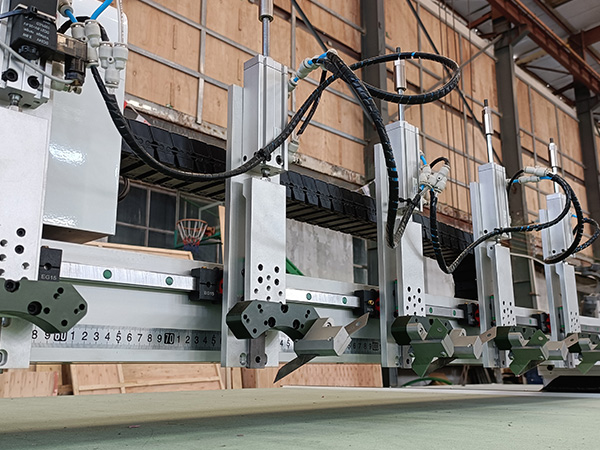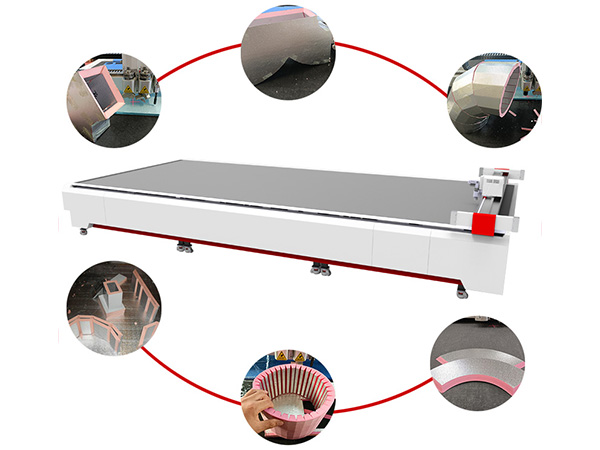The middle layer of the phenolic composite air duct is made of phenolic foam, and the upper and lower layers are made of embossed aluminum foil, which is widely used in the air-conditioning system. Due to its good thermal insulation, good noise reduction and lightweight, phenolic composite air duct has become the best air duct material to replace galvanized steel and glass fiber reinforced plastic. It is suitable for industrial and civil buildings, hotels, hospitals, office buildings, and other special places.
The production process of traditional pre-insulated phenolic duct:
When carrying out the construction of phenolic air ducts, first of all, workers need to draw engineering drawings according to the construction site, decompose the engineering drawings, determine the installation positions of air-conditioning equipment and air duct components, and disassemble the air duct system into straight air ducts and elbows , variable diameter, tee, cross and other shapes.
Secondly, the specification and quantity of air ducts are calculated by experienced workers, that is, the reasonable length and quantity of straight air ducts and special-shaped ducts, and lines are measured on the phenolic board to make rectangles, T-shapes, bends, reducers, etc. Stake out different pipes, and then use a paintbrush to draw cut-off lines, V-grooved lines, and 45-degree slope lines.
Finally, the worker cuts off the excess material with a knife along the marked line. First place the board on the workbench, then fix the ruler in parallel at the proper position, The worker holds the tool, puts the reference edge of the tool against the ruler, the planing surface presses the board, the reference line of the tool is aligned with the lofting line, and then pushes the tool forward or pull back.

Disadvantages of Using Milling Cutters for Manufacturing Insulated Phenolic Ducts
While milling cutters can be used for shaping and cutting insulated phenolic ducts, this approach has several disadvantages compared to more modern methods like CNC Oscillating Knife Cutting Machines. Here are some of the key drawbacks:
Material Waste
Lower Material Efficiency: Milling often results in more material waste compared to precise cutting methods.
Quality and Precision
Rough Edges: Milling can leave rough or jagged edges, which may require additional finishing processes.
Lower Accuracy: The milling process may not be as precise, affecting the overall quality and dimensional accuracy of the ducts.
Operational Issues
Tool Wear: Milling cutters can wear down faster, requiring frequent replacements.
Higher Energy Consumption: Generally consumes more energy compared to more modern cutting technologies.
Increased Noise Levels: Milling machines can be significantly noisier, affecting the work environment.
Time and Cost
Slower Production Rates: Milling is generally slower than other cutting technologies, affecting overall production efficiency.
Higher Labor Costs: May require skilled operators and more manual intervention, driving up labor costs.
Safety Concerns
Dust Production: Milling can produce a lot of dust, requiring robust dust extraction systems and posing potential health risks.
Given these disadvantages, many manufacturers opt for more advanced and specialized machinery like CNC Oscillating Knife Cutting Machines, which offer greater precision, speed, and efficiency.

3 Advantages of AMOR CNC Pre-Insulated Phenolic Duct Cutting Machine
While milling cutters can be used for shaping and cutting insulated phenolic ducts, this approach has several disadvantages compared to more modern methods like CNC Oscillating Knife Cutting Machines. Here are some of the key drawbacks:
- Superior Production Process
Traditional CNC Insulation Cutters: These typically use milling cutters, generating dust during the cutting and grooving process.
AMOR CNC Phenolic Foam Cutters: Utilize high-frequency oscillating cutting technology, ensuring a smooth cut surface and a dust-free work environment. This is a more eco-friendly and healthy production method. - High-Quality Components
Japanese Mitsubishi Servo Motors: For powerful and precise movements.
French Schneider Electric Components: For reliable electrical performance.
Japanese Omron Photoelectric Limiters and Taiwanese HIWIN Guide Rails: For accurate cutting.
Knife Frame System with PMI Guide Rails, Japanese TBI Screws, NSK Bearings, and Italian Megaudi Belts: All work in harmony to ensure stable and smooth cutting.
Dual Mitsubishi Servo Motors with Precision Reducers: In conjunction with rack and pinion transmission for robust and stable cutting performance. - Industry-Specific Expertise
Rich Experience in Phenolic Foam Duct Automation: AMOR has extensive experience in automating the production of phenolic foam ducts.
Efficiency: Our machines come equipped with 5 passive beveling tools, capable of completing a 2-meter-long straight duct within 8 seconds.
Ease of Use: Each machine is paired with specialized duct design software. Clients can simply choose the duct style they wish to produce from a library, input the dimensions, and obtain the processing diagram. No specialized CAD experience is required.

AMOR Professional CNC Cutting Machine for Insulating Phenolic Foam
AMOR1640MK pre-insulated pipe cutting machine is a fully automatic CNC machine tool, completely designed by ourselves, and the bed adopts high-quality overall welding technology. It cuts straight and specialty parts from insulating panels for use in the fabrication of pre-insulated HVAC ductwork as well as duct and pipe insulation.
With our simple, smooth operating system, complex graphics and products can be cut and produced easily, accurately and quickly. Our unique software version brings you a complete solution that revolutionizes the manufacturing of insulated duct systems for the HVAC industry.
Our specially designed automatic tool changing system, V-grooving and cutting panel shapes can be done in one process, resulting in significant cost savings in all aspects. It comes with an extensive library of piping component parameters, allowing full control over panel configuration and dimensions. All phenolic panels can be nested to maximize panel utilization and reduce material costs.
Advanced automatic computing power and automation technology eliminate the traditional labor-intensive work required to produce duct panels, eliminating the need to manually mark, create templates or use hand-held tools to cut.
The pipe cutter obtains the finished product of pre-insulated pipe; manual work and bending are no longer required and the resulting parts are ready for gluing. Standard machines come with a host of accessories and equipment designed to reduce production time and produce the best quality finished product.
The working size is 4000x1600mm, which can make full use of phenolic foam board. The production efficiency is greatly improved, material waste is reduced, and the production cost of air duct manufacturing is saved. Different shapes can be cut at one time, such as elbow type, shoe type, Y type, reducer, etc.
Customers are very satisfied with this CNC air duct milling machine, especially compared to other brands on the market, ours is stable, fast and more cost-effective. Long-term cooperation and support enable us to make continuous progress.
Pre-insulated pipes.
| Model | AMOR1640MK |
| Working format | 1600X4000mm |
| Tool combinations | Oscillating Cut Tool + Bevel Tool + Marking Tool |
| Safety | High sensitivity infrared induction |
| Cutting speed | Max. 1500mm/s(please set the speed according to the material) |
| Drive system | Y-axis Japan Mitsubishi servo motor + precision reducer drive; X-axis double Japan Mitsubishi servo motor + precision reducer drive; Z-axis Japan Mitsubishi servo motor + TBI ball screw; Taiwan HIWIN guide rail, high precision rack. |
| Machine power | 11KW |
| Power supply | AC220V/380V; 50HZ/60HZ |
| Supported file data | DXF /AI /PLT |
| Work environment | Temperature 0℃-40℃ humidity 20%-80%RH |
Cutting Tool for Insulated Phenolic Air Ducts
If you’re in the business of producing phenolic foam ducts for HVAC systems, AMOR offers a specialized tooling configuration to streamline your production process. Here’s how we enhance your workflow:
Comprehensive Tooling Suite
Oscillating Cutting Tool: For precise and efficient cutting of the foam material.
Beveling Tool: To create angled cuts or grooves that facilitate easier assembly and better airflow.
Marking Tool: For labeling parts, ensuring straightforward assembly and quality control.

Exceptional Efficiency with Passive Beveling Tools
For square duct grooving across the entire sheet, we recommend a configuration featuring 5 passive beveling tools.
Achieve the production of a 2-meter long straight duct in just 8 seconds.
This results in a 5-fold increase in cutting efficiency compared to conventional methods.
By opting for AMOR’s recommended tooling configuration, you not only ensure the quality and precision of your ductwork but also significantly enhance your production speed. It’s a win-win for both quality and efficiency.

How AMOR’s Phenolic Duct Cutting Machine Works
The AMOR Phenolic Duct Cutting Machine is engineered to optimize the production process of phenolic foam ducts for HVAC systems. Here’s a step-by-step breakdown of how this state-of-the-art machine operates:
Step 1: Preparing the Material
The phenolic foam sheet is securely placed on the machine’s cutting table.
Step 2: Loading the Design
The operator uploads the duct design into the machine’s control system, usually via specialized duct design software.
Step 3: Tool Configuration
The machine automatically selects the appropriate tools based on the design. This could be an oscillating cutting tool for cutting, a beveling tool for angled cuts, and a marking tool for labeling.
Step 4: Calibration and Initialization
The machine calibrates to ensure optimal cutting accuracy.
Once calibration is complete, the initialization process begins, setting the machine to its starting position.
Step 5: Cutting and Grooving
The machine starts the cutting and grooving process.
For square ducts, 5 passive beveling tools can be utilized to create grooves across the entire sheet, significantly boosting efficiency.
Step 6: Marking
If marking is needed, the machine will automatically switch to the marking tool to label parts for easier assembly and quality control.
Step 7: Finalization
After the cutting and marking are complete, the machine stops, and the finished duct pieces are ready for removal and assembly.
By automating many of the traditional steps in duct production, the AMOR Phenolic Duct Cutting Machine offers a combination of precision, efficiency, and ease of use that sets it apart in the market.



